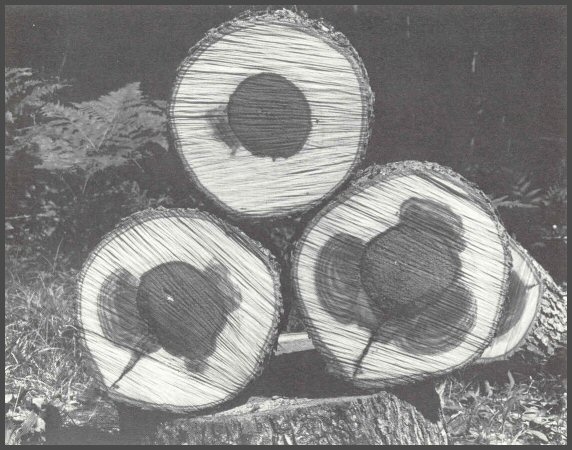
Pages 92-121
64. When very serious wounds are inflicted, heartwood formation may be stalled. The wood present when this white oak was wounded was decayed to an advanced state. Note the erratic pattern of heartwood formation. The upper section looks as if no heartwood had formed.

65. Radial cracks splitting outward from the central defect. It is not
uncommon for oaks to have very small central columns of discolored and decayed
wood, associated with wounds that were inflicted when the tree was very young.
These became the starting points for cracks. This pattern is often called
spiderheart or heartshake. The pattern is also common in planted pines
that were injured at the time of planting. The same patterns and problems
occur with orchard trees that receive wounds at the time of planting.
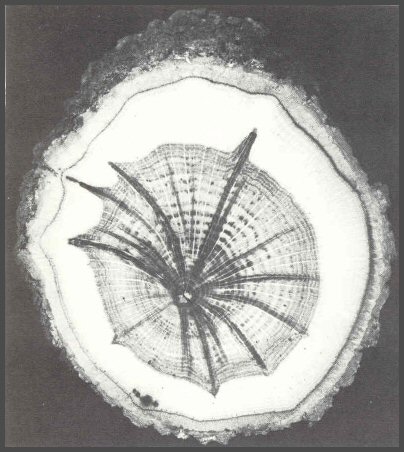
66. This black walnut was wounded when it was less than an inch in diameter. As the growth ring inroll started, it started a radial seam. In later years, if the tree had not been cut, it would be difficult to understand how a crack on one side of the base was started by a wound on the other side.
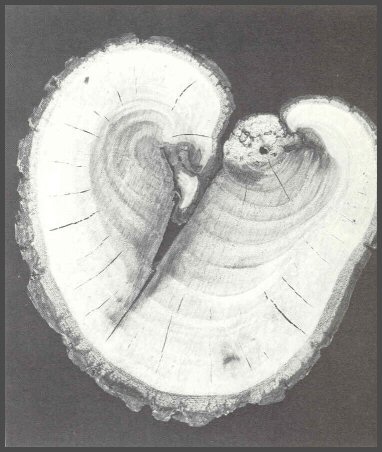
Pages 92-93
67. Discolored wood often develops along the crack zone. The arrows in this red maple show the barrier zone and the starting point for the cracks. Cracks pose difficult problems for trees. Only Walls 3 can effectively hold the cracks to some reduced size. When cracks break out to the cambium, the tree responds as it would to a new wound. But there are limits to the compartmentalizing effect, because further splitting may continue from the inside outward. Some decay-causing fungi often follow the cracks outward, and can spread throughout heartwood this way.
Long cracks are also common in many conifers, especially western hemlock. Old fire wounds and logging wounds are usually the starting point. When long cracks develop at opposite sides of a tree, this is a serious sign for a potential hazard tree. Cracks should be the first sign to consider when assessing trees for potential hazards. Why some wounds lead to cracks while others do not still needs clarification. It does appear from dissections that the wounds that do lead to cracks are those that are inflicted on smaller trees, and especially rapidly growing smaller trees. The growth ring inroll then closes rapidly and may actually "cut in" at the edges of the wound. The formation of barrier zones also plays a major role in cracking. Factors that favor a large barrier zone also favor ring separations that will favor radial cracks. Many wounds can be prevented, and they must be if we are to grow healthy, high-quality trees.
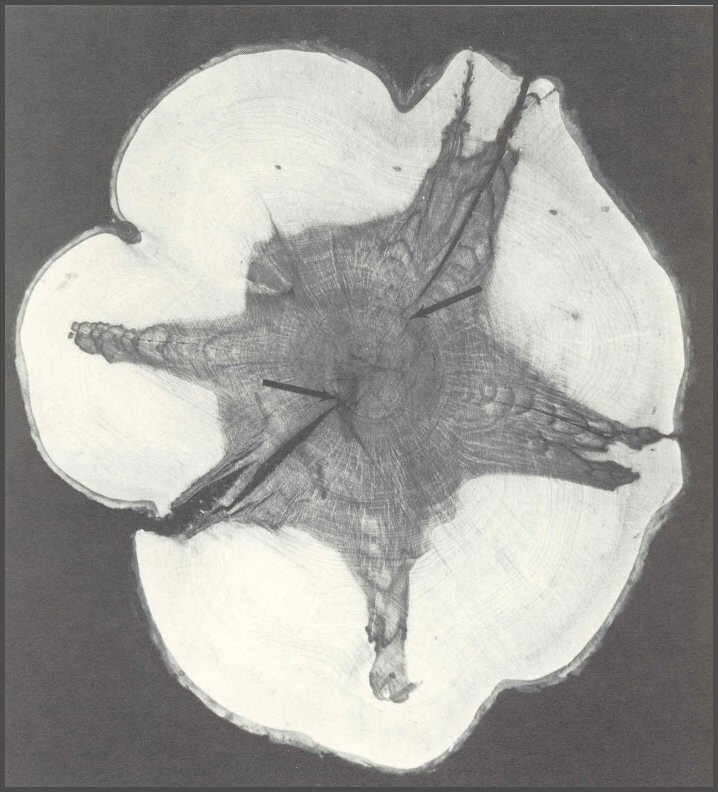
Pages 94-95
68. Big trees with big defects are not very valuable. One of the most damaging defects on most species of conifers is ring rot, caused by the fungus Fomes pini and some of its variants. Because of the ring patterns of defect, it is often impossible to cut clear boards. Small amounts of ring rot do not cause serious damage to construction timbers. The tree being cut here is a Douglas-fir in the Pacific Northwest.
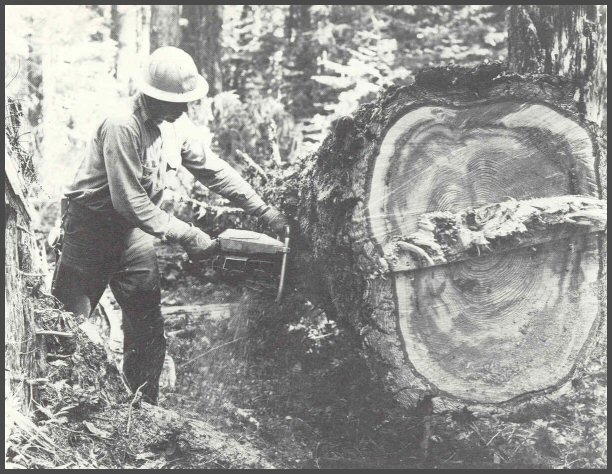
69. Decays caused by other fungi are also serious defects in many species of conifers. The CODIT model is applicable to these defects. The small arrows show the walling off of an advanced column of decayed wood. Note also the triangular shape of the decayed column. The medium-size arrows show an old Wall 4 and out from it are cracks and decayed wood along the cracks. The large arrow shows the end of a wound, the circumferential crack or shake, and the radial crack splitting outward.
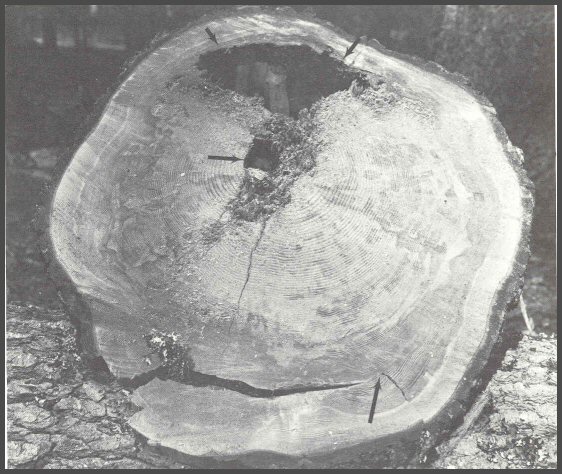
Pages 96-97
70. Fruit bodies of Fomes pini usually form where the old branch wood protrudes. Below this stub is the fungus material that acts as a wedge into the bark. When the wedge kills cambium, the tree responds by producing resin-soaked wood.
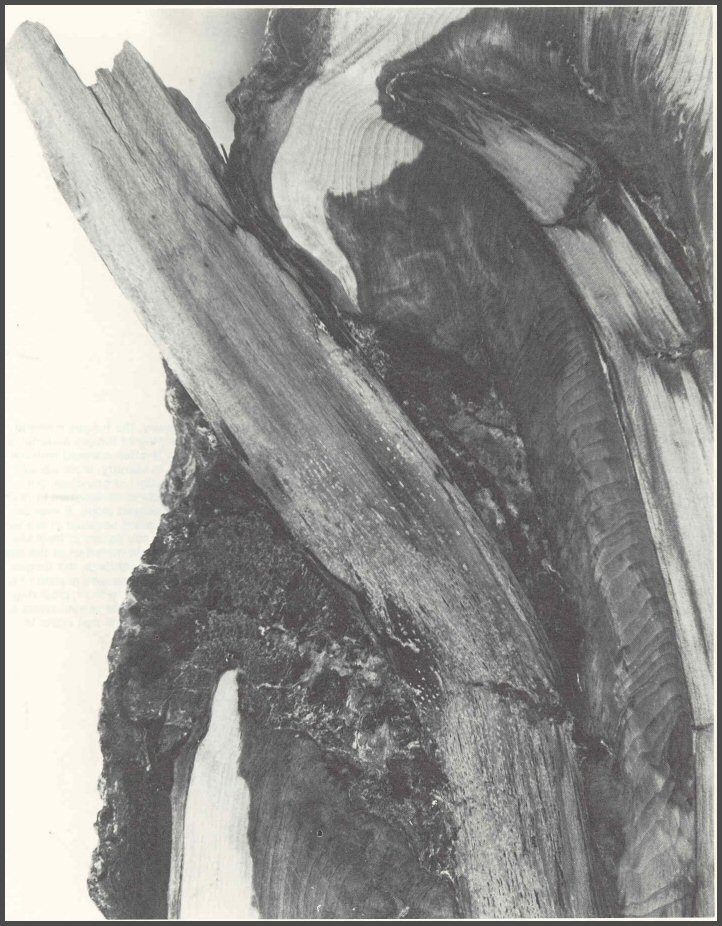
Pages 98-99
71. The fungus material is below this broken stub. The tree produces the resin-soaked material in the aging sapwood at the sapwood-heartwood boundary. This results in a strip of decayed wood with sound wood on both sides.
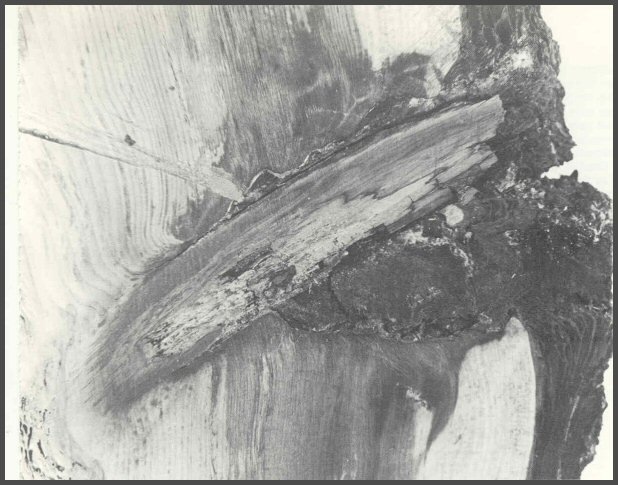
72. When the stubs fall away or are decayed away, the fungus material forms a plug in the branch stub area. This plug of fungus material is called a blind knot, or punk knot. The knot is often covered with old bark plates and resin, and may be difficult to identify. Most decay- causing fungi do not attack the inner core wood of branches, but Fomes pini does. The fungus appears to become established in resin ducts, hence the fleck-type pattern to the decayed wood. It may be that the fungus cannot advance into the sapwood because of the very large amount of resin material that separates the sapwood from the fungus. It may be that the concentration of resin materials at the sapwood-heartwood boundary suits the fungus. Regardless, the fungus does spread in the discolored and partially resin soaked growth rings at the sapwood-heartwood boundary. This results in the typical ring pattern. In some trees Fomes pini invades the entire central wood and no ring pattern forms. This is common in spruce and can occur in Douglas-fir.
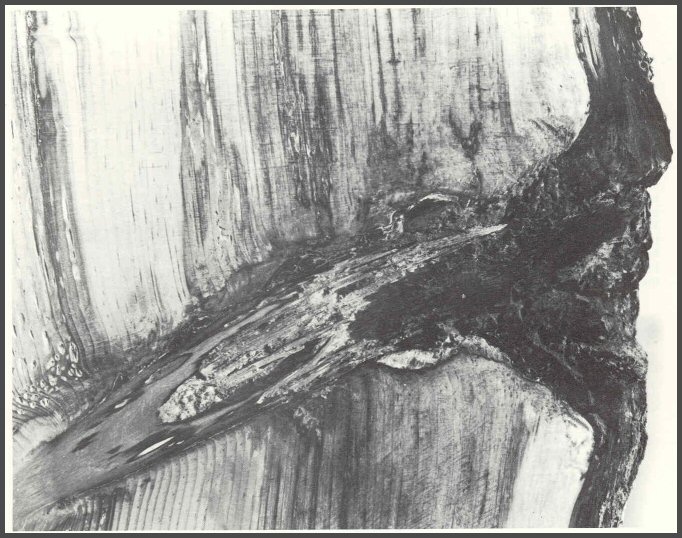
Pages 100-101
73. Root rots cause serious problems to trees. One of the major root rots is caused by Fomes annosus (Heterobasidion annosum). The fungus does kill roots. When the tree recognizes the infection, compartmentalization begins. The tap root in this red pine was killed by the fungus. As the fungus spread upward it was walled off by the tree (arrows). The wood that continued to form after infection was compartmentalized and clear. The arrows show the barrier zone that separates the infected wood from the healthy wood. When so much of the tree is walled off, a critical point may be exceeded, and the entire tree may die. Compartmentalization is beneficial in small amounts, but in large amounts it may be counterproductive.
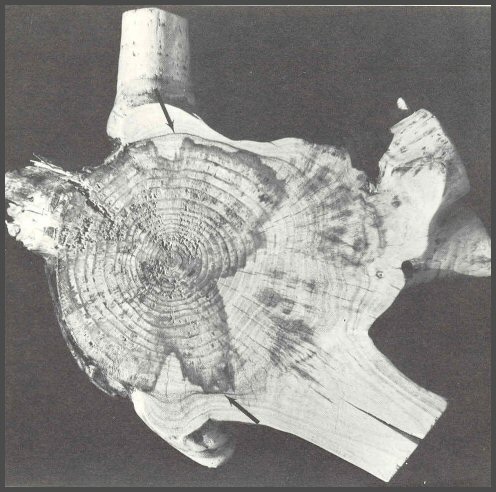
74. Another root rot that causes major problems worldwide is incited by
Armillaria mellea and related species of Armillaria. The disease is
often called "shoestring root rot" because the fungus produces long strands of
fungus tissue that resemble black shoestrings. The "shoe- strings" are
rhizomorphs. They often entwine around healthy roots as well as weakened
roots. After stress, weakened roots may be infected, or the rhizomorphs
may grow into the root. Basal sprouts often form around trees killed by A.
mellea.
A root of red spruce killed by A. mellea (arrow). The dead root
is walled off as it enters the larger root. Larger roots continue to wall
off smaller roots, until a threshold is reached and the larger root dies. Then
the sequence of walling off continues upward until the butt and trunk are met.
When so much of the tree is walled off, death follows. Most trees infected
with A. mellea persist for long periods with many infections. After
the threshold is reached, death comes quickly. It is the "sudden" death
that is recognized.
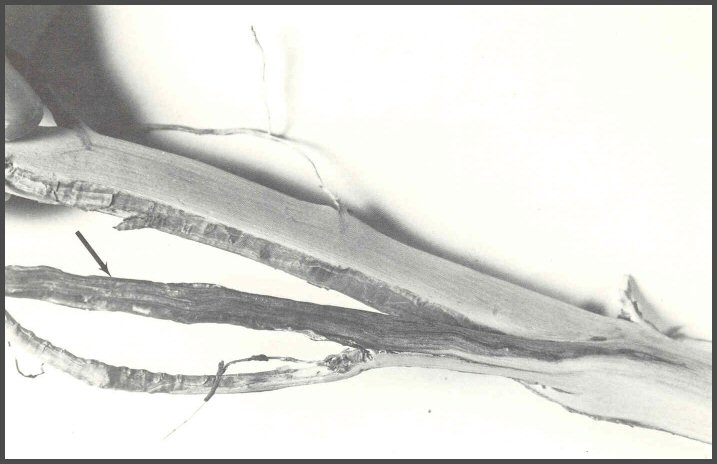
Pages 102-103
75. Armillaria mellea infects bark first, and then the wood. The fungus spreads in bark until it is recognized and compartmentalized. It is possible that the fungus could girdle roots before it was recognized. In this red spruce butt the small arrows show the extent of the original bark infection at the time of compartmentalization. The fungus spread again later in the bark, and was recognized and compartmentalized at the position of the large arrow. Note that the decayed wood at A did not spread into the center of the tree. A. mellea appears to spread most rapidly in sapwood or wood that still has some living cells at the time of infection. Roots compartmentalize just as trunks do.
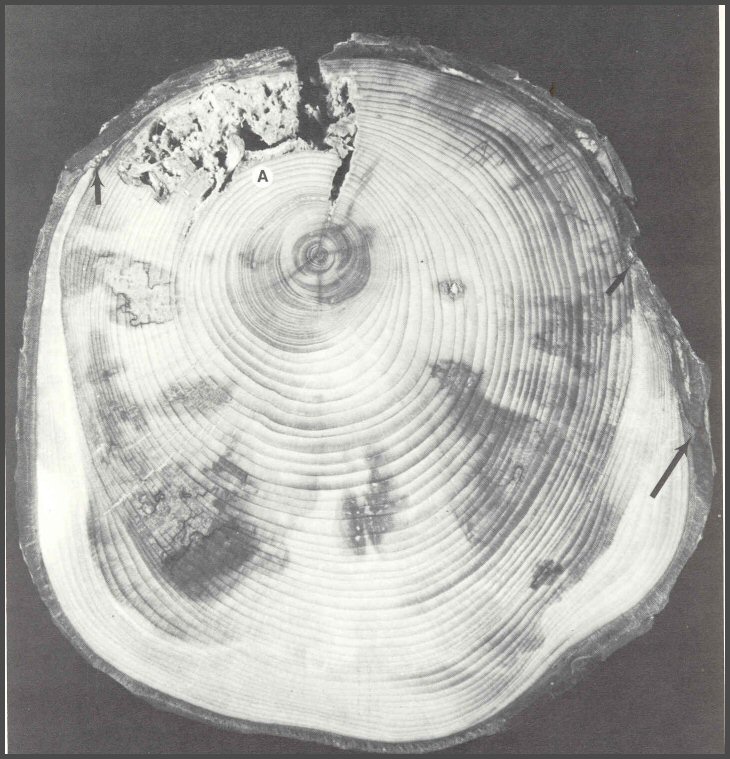
Pages 104-105
76. Dissection of a basal section of a Balsam fir. The lower portions of roots are infected and decayed first. The bottoms of the roots have a tissue connection with the between-root portion of the tree base; thus the decay spreads upward from the bottom of the root to the tissue between the roots. The infected wood is compartmentalized from the upper section downward. It appears to be spreading outward, but as viewed from the lower sections upward, is actually moving inward. Wetwood develops in the same way, from the roots upward.
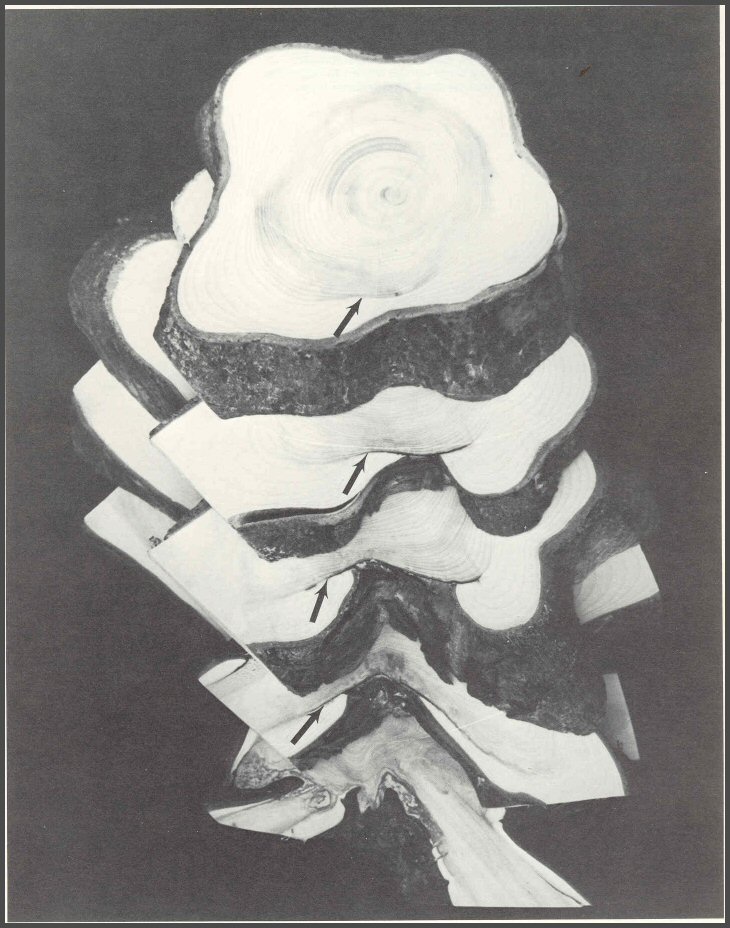
Page 106-107
77. Butt of aspen with an old infection of A. met/ea. The infection killed the large root, and spread laterally and upward into the trunk about 18 years before the tree was cut. The small arrows show the size of the root when the infection was compartmentalized, and the large arrow shows the size of the trunk base when the infection was compartmentalized. Note that the infection did not spread inward to the center of the tree, but inward to another barrier zone from another injury.
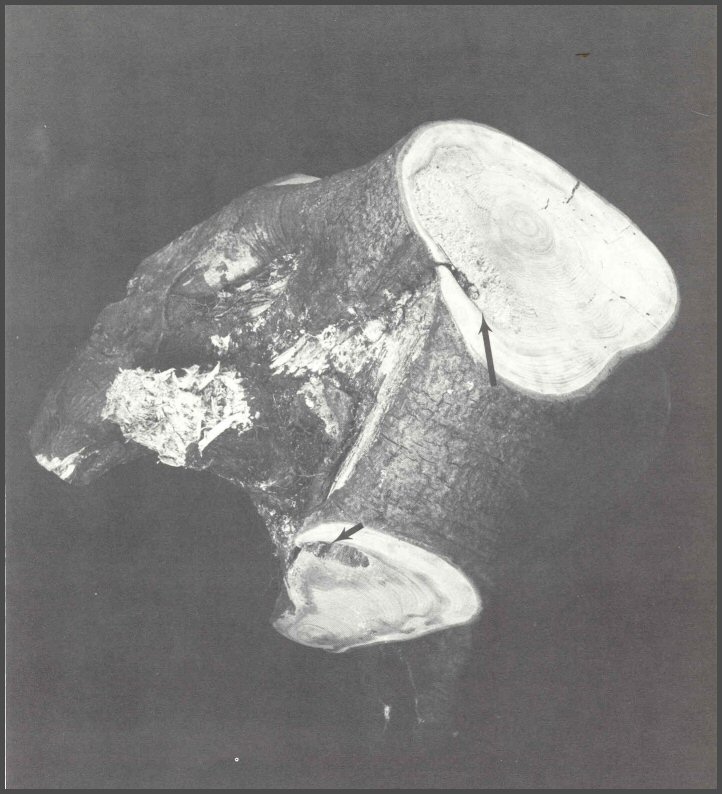
Pages 109-109
78. A lower trunk section from an aspen infected by A. me/lea. The decayed wood spread to the center here because no older barrier zones were encountered. Note the infection in the bark (large arrow). Walls 3 resisted lateral spread (small arrows). Discolored wood bordered the decayed wood. It may spread for great distances in the wood, far beyond where it was stopped in the bark. But, where it spreads in the wood, it spreads only in the wood present at the time of bark infection. The fungus does not move outward radially to infect bark again.
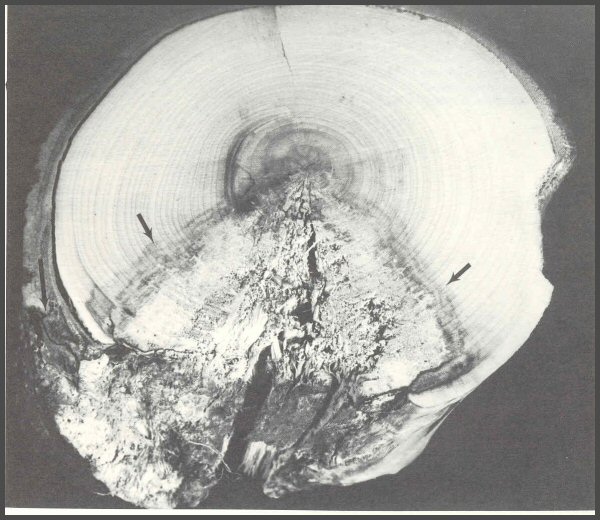
79. A lower trunk section of aspen infected by A. mellea. The large arrow shows Wall 4 associated with an older column of decayed wood. The small arrow shows Wall 4 associated with a more recent infection. The decayed wood may spread for a great distance within the wood present at the time of infection.
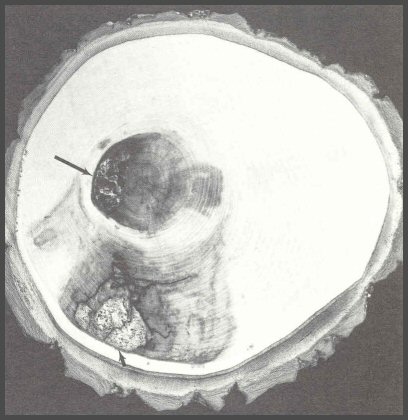
Pages 110-111
80. Multiple cracks on balsam fir indicate serious internal decay and internal cracking. Cracks at the base of balsam fir usually indicate root and butt rot. A. mellea is usually, but not always, the fungus involved. Resin often flows from old branch core sockets on trees infected with root rot. Trees with basal cracks should be cut as soon as possible. Some forest areas are root-rot areas because the fungus is kept vigorous on dead roots of cut trees. When balsam fir is cut, more balsam fir grows again. Root rots are common in many fir areas.
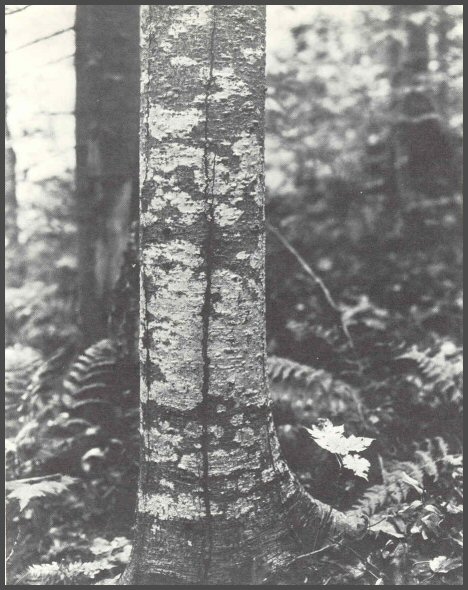
81. The basal section of the tree shown in the previous photo shows the central hollow and the radial cracks splitting out from the hollow. A great amount of wetwood is associated with the roots and the butt. Trees with root and butt rot often break near the base. Such trees in an area indicate a root rot zone.
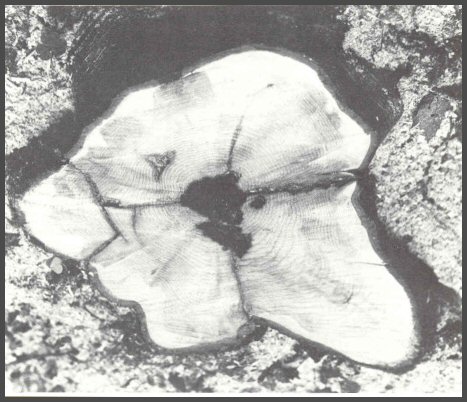
Pages 112-113
82. Large collar cracks form on root-rotted birch. Trees with such collar cracks should be cut as soon as possible.
Collar cracks start when support roots are rotted. Cracks that start at the butt spread upward.
Armillaria mellea and its related species infect many species of trees worldwide.
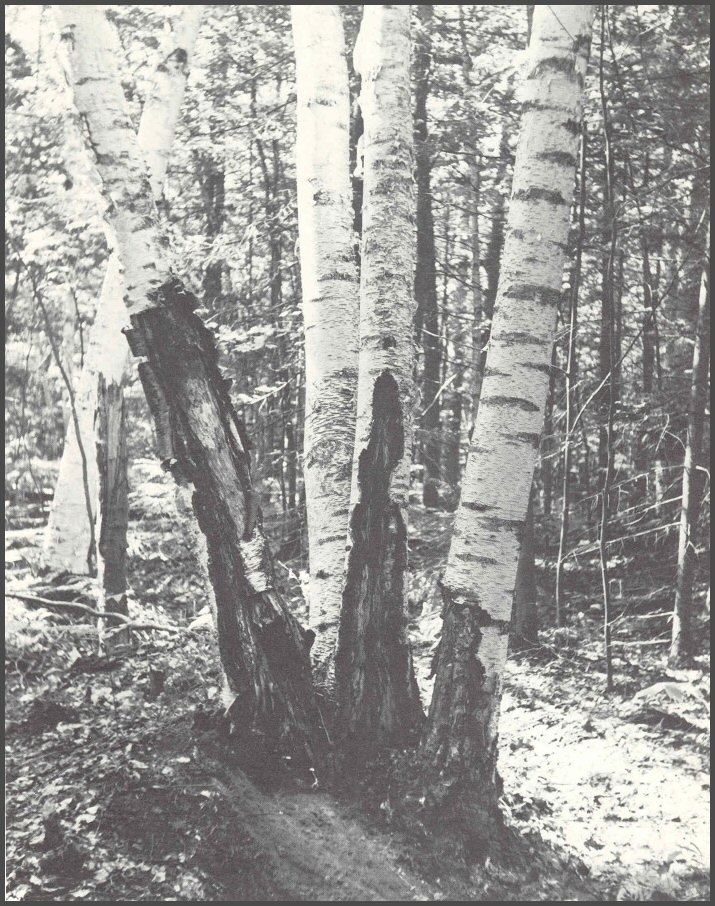
Page 114 to 115
Page 116 was a blank page.
Pause
CODIT is a model of compartmentalization. Compartmentalization is a highly ordered boundary-setting process to resist the spread of infection. The process is not absolute. It does not function perfectly all the time. When it does not function effectively, some part of the tree, or the entire tree, may die. Our responsibility is to understand the natural processes of buildup and breakdown well enough to be able to prevent, detect, or regulate them. And when this cannot be done, then predict their movement over time accurately. In forestry, the group of trees must be considered. In urban forestry or horticulture, or in orchards, the single tree must be considered. Treatment of trees to prevent and "cure" diseases has been a personal art form. Many treatments arose from practices used in human medicine. It is time to reexamine many tree care practices on the basis of new information and of new pressures inflicted on trees. Science is a constant reexamination process in search of, and in documentation of the truth. Truth is order.
The more we understand the order of natural systems, the more we will be able to make the best decisions, most of the time. Some common tree treatments have been reexamined:
wound dressings, cavity filling, wound scribing or tracing, cabling and bracing, injections and implants, and most important, pruning. For the good of our trees, some adjustments must be made.
Page 117
83. Wound dressing has been the hallmark of the arborist. Wound dressings were used to prevent or stop decay, but there are no data to show that any wound dressing prevents or stops decay. Studies that included dissections and isolations showed that trees with wound dressings were no better off than the untreated controls. The four wounds on the left were on one red maple tree, and the four wounds on the right were on another red maple tree. The dark-faced wounds were coated with a common wound dressing. Note the dieback associated with the wounds. Dissections showed no difference between the two trees in the amount of discolored and decayed wood. This photo was taken 1 year after treatment. Bark was removed to show the dieback.
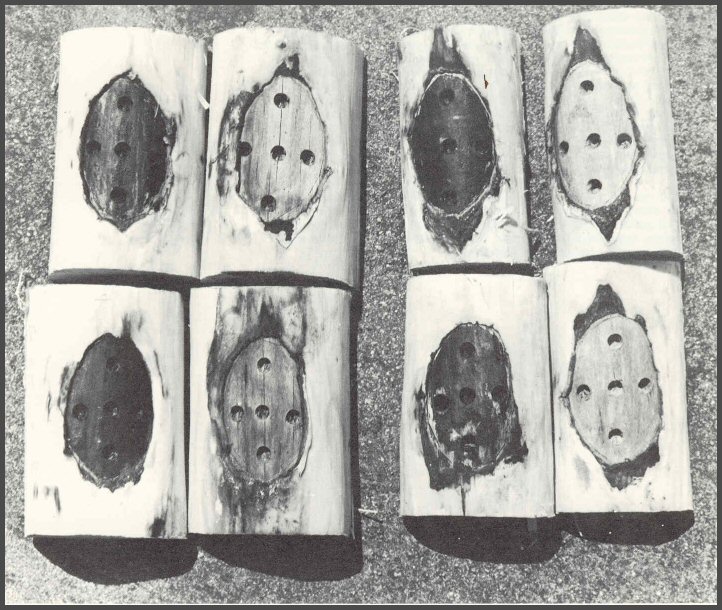
Pages 188-119
84. Seven-year old treated and control wounds on seven red maple trees. Each tree received four wounds, three of them treated and one control. The treatments were a very common black asphalt-based dressing, orange shellac, and a rubber-type material, plus the untreated controls. Note similarities in callus formation and dieback pattern on the four wounds from each tree-four per horizontal row. Note also that some dressed wounds have no decay associated with them while others do. Why? A closer look will explain why. When the experimentally inflicted wounds injured wood very close to inner defects, decay developed. When there was a wide band of healthy wood separating the inner defect from the experimentally inflicted wounds, no decay developed. These results show again the importance of wounds that decrease the volume of healthy wood in a tree.
Seven red oak trees wounded and treated the same as the red maples were also cut and dissected after 7 years. The strong effect of individual genetic traits was shown with the oaks. Some trees closed all wounds, regardless of treatment. No wood decayed, and there was only a small column of discolored wood.
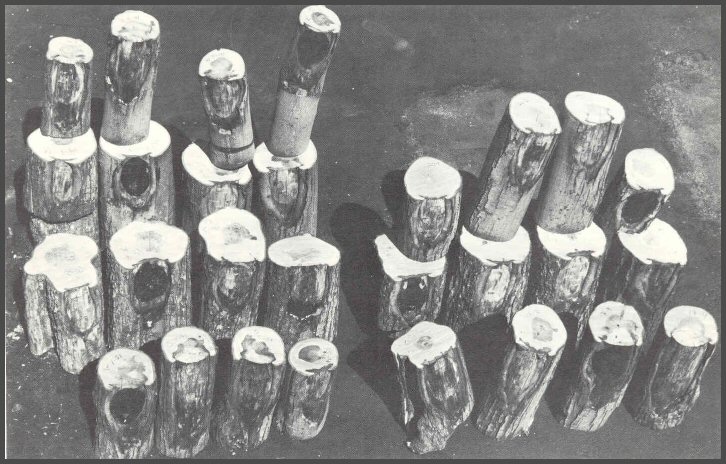
Page 120-121